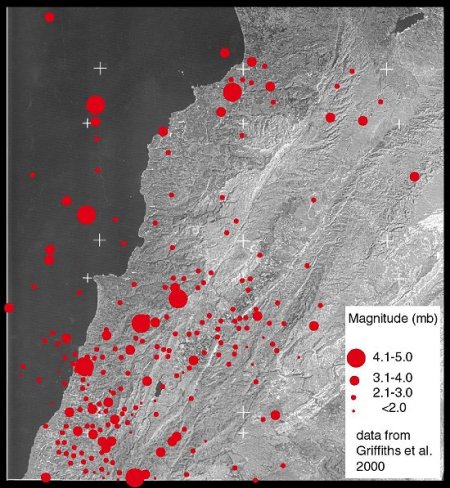 Analyses
of seismicity in Lebanon have been greatly hindered by very poor instrumentation
coverage. Local stations are restricted to Israel: there is only one station
in Lebanon itself (at Bhannes, about 15km east of Beirut). Thus precise hypocentre
locations are possible only for large-magnitude events (Plassard & Kogol
1981). However, the seismicity recorded instrumentally shows an important pattern.
As recognised by Girdler (1990), the northern part of Lebanon is largely aseismic.
Analyses
of seismicity in Lebanon have been greatly hindered by very poor instrumentation
coverage. Local stations are restricted to Israel: there is only one station
in Lebanon itself (at Bhannes, about 15km east of Beirut). Thus precise hypocentre
locations are possible only for large-magnitude events (Plassard & Kogol
1981). However, the seismicity recorded instrumentally shows an important pattern.
As recognised by Girdler (1990), the northern part of Lebanon is largely aseismic.
However, the Levant has been prone to occasional very large earthquakes,
not evident in the instrumental record of the past century (Plassard & Kogol
1981). Ambraseys & Barazangi (1989) suggest that the northern part of the
Yammouneh fault system has merely been in a period of seismic quiescence. They
describe clustering of devastating earthquakes, most notably in the 18th century,
in the Bekaa valley. Although there were surface ruptures within the Bekaa valley,
these have long since been obliterated. Consequently the kinematics of these
historical events is unknown.
Detailed seismological work has been restricted to the south of the restraining
bend, largely within Israel where instrumentation is present. Van Eck &
Hofstetter (1990) show seismicity for the period 1982-89 to be clustered spatially
along mapped segments of the transform. Focal mechanisms are largely consistent
with N-S left-lateral faulting but include N-S extension and E-W compression
adjacent to the intersection of the Carmel Fault with the main transform axis.
Hofstetter and co-workers (van Eck & Hofstetter 1990, Shapira & Hofstetter
1993) show the main locus of larger magnitude earthquakes to coincide with the
Roum Fault.
Notwithstanding the technical problems to estimating event locations, micro
seismicity is spread in a broad swathe in southern Lebanon. Although there is
a general N-S trend of earthquakes along the trace of the Roum Fault, there
is a substantial amount of seismic energy distributed away from the main faults.
As discussed elsewhere, it is most unlikely that all this seismicity has occurred
on major transcurrent faults such as the Yammouneh or Roum.
 Analyses
of seismicity in Lebanon have been greatly hindered by very poor instrumentation
coverage. Local stations are restricted to Israel: there is only one station
in Lebanon itself (at Bhannes, about 15km east of Beirut). Thus precise hypocentre
locations are possible only for large-magnitude events (Plassard & Kogol
1981). However, the seismicity recorded instrumentally shows an important pattern.
As recognised by Girdler (1990), the northern part of Lebanon is largely aseismic.
Analyses
of seismicity in Lebanon have been greatly hindered by very poor instrumentation
coverage. Local stations are restricted to Israel: there is only one station
in Lebanon itself (at Bhannes, about 15km east of Beirut). Thus precise hypocentre
locations are possible only for large-magnitude events (Plassard & Kogol
1981). However, the seismicity recorded instrumentally shows an important pattern.
As recognised by Girdler (1990), the northern part of Lebanon is largely aseismic.